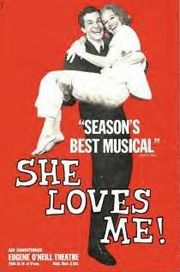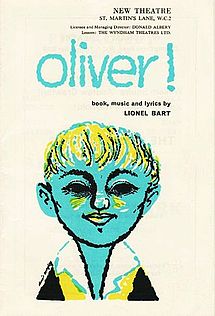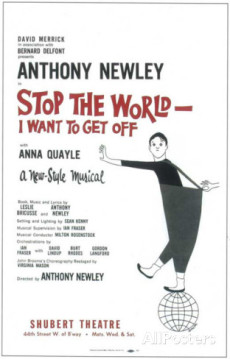
From Broadway To 52nd Street
She Loves Me opened the Eugene O’Neill Theatre on April 23, 1963 and the show ran for 301 performances. Sheldon Harnick penned the lyrics and Jerry Bock composed the music to the tune She Loves Me which has entered into the pantheon of jazz standards. The musical starred Barbara Cook, Daniel Massey, Barbara Baxley and Jack Cassidy.
The Story: Set in Hungary in the late 1930s, the story follows two coworkers George and Amalia who unwittingly meet through a Lonely Hearts column. As the two anonymously write love letters to each other, things don’t go so well at work. Not knowing that they are each other’s pen pal, they constantly fight. Further Georg’s boss, Mr. Maraczek, who thinks George is having an affair with his wife, constantly criticizes George at work. Eventually, the boss realizes that another clerk is having the affair. In the end Georg and Amalia discover that they are each other’s pen pal and they fall in love.
Broadway History: The alternative theatre movement aimed to break these commercial and psychological restraints by bonding spectator and audience and by lessening the theatrical illusion of an imagined space and time. Conventional theatre taught the spectator to lose himself in the fictional onstage time, space, and characters; conversely, alternative theatre relied on the spectator’s complete consciousness of the present. This present is the real time and space shared by the audience and the performers; only when the audience consciously perceives the present can they perceive the theatrical experience as relevant to their lives, and not as escapist fiction. The primary importance of the spectator’s consciousness of the present is that he is an active force in creating the theatrical event rather than a passive observer of a ready-made production.
Sponsored By
www.whatissuitetabu.com

From Broadway To 52nd Street
Oliver! opened at the Imperial Theatre on January 6, 1963 and ran 774 performances. Lionel Bart wrote the book and the lyrics and composed the music. One of his songs, Where Is Love became a jazz favorite.
The Story: Musical adaptation of Dickens story in which a young Oliver, an orphan in a workhouse, asks for more of the meager gruel from a surprised matron. Punished for beating up another boy who made fun of his dead mother and locked in a coffin but he escapes. Living on the streets of London he is befriended by the Artful Dodger who introduces him to Fagin, a criminal teaching young boys to become pickpockets. The thieving children are manipulated by their leader and mentor Fagin, and the young Oliver, who through circumstances is forced into a life of crime. Greed of the workhouse caretakers leads to Oliver’s ultimate rescue by a kindly old gentleman who realizes Oliver is his great nephew. The musical, as is the book, was a powerful statement on the 19th century poverty, crime and government neglect crying out for social reform.
Jazz History: By the 1960s, most of the legendary clubs were razed or fell into disrepair. The last club there closed its doors in 1968. Today, the street is full of banks, shops, and department stores and shows little trace of its jazz history. The block from 5th to 6th Avenues is formally co-named “Swing Street” and one block west is called “W. C. Handys Place”.
The 21 Club is the sole surviving club on 52nd Street that also existed during the 1940s. The venue for the original Birdland at 1674 Broadway (between 52nd & 53rd), which came into existence in 1949, is now a “gentlemen’s club”. The current Birdland is on 44th Street, between 8th and 9th Avenues.
Sponsored By
www.whatissuitetabu.com

From Broadway To 52nd Street
Stop The World I Want To Get Off opened at the Shubert Theatre on October 2, 1962. Running for 555 performances The music and lyrics were composed by Leslie Bricusse and Anthony Newley. The musical starred Anthony Newley as Littlechap and Anna Quayle portrays Evie. Fortunately for the jazz world one of their tunes would enter the pantheon of jazz classics – What Kind Of Fool Am I.
The Story: Set against the backdrop of a circus, it focuses on Littlechap, whose first major step towards improving his lot is to marry Evie, his boss’ daughter. Saddled with the responsibilities of a family, he allows his growing dissatisfaction with his existence to lead him into the arms of various women – Russian Anya, German Ilse, and American Ginnie – as he searches for something better than he has, only to realize in the twilight of his life what he always had – the love of his wife – was more than enough to sustain him.
Broadway History: In 1950, the tradition of the gypsy robe was born on Broadway, when a chorus member in Gentlemen Prefer Blondes sent the worn-out robe of a fellow chorus member to a friend in a different production. Since then, the robe has been passed to the chorus member with the most credits on the opening night of Broadway plays, with each former “gypsy” adding a prop from his or her performance.
Sponsored By
www.whatissuitetabu.com

From Broadway To 52nd Street
No Strings opened the curtain at the 54th Street Theatre on March 15, 1962 and ran for 580 performances. The musical starred Richard Kiley and Diahann Carroll performing music composed by Richard Rodgers, and The Sweetest Sounds and Loads of Love went on to become part of the classic jazz lexicon.
The Story: In Paris, David Jordan, a prize-winning writer suffering from a long dry spell meets a black model, Barbara Woodruff. Their budding romance wilts when David learns that a wealthy admirer has kept Barbara. Later they resume their affair but after recognizing that an interracial marriage would be doomed, they go their separate ways.
Jazz History: When trumpeter Miles Davis, under the influence of James Brown, Sly Stone, and Jimi Hendrix, crossed over to a new rock-inflected form with his influential Bitches Brew album in 1970, the new sub-genre of jazz-rock fusion gained jazz legitimacy for about a decade. Numerous graduates of Davis’ experiment—including pianists Herbie Hancock, Keith Jarrett, Joe Zawinul, and Chick Corea, drummers Tony Williams and Jack DeJohnette, percussionist Airto Moreira, saxophonist Wayne Shorter, guitarist John McLaughlin, and bassist Dave Holland—went on to success as leaders or members of 70s fusion super groups like Weather Report, Return to Forever, Lifetime, and the Mahavishnu Orchestra. Fusion was followed by a lighter, radio-friendly style called smooth jazz, which ultimately diminished the legitimacy of fusion in the minds of jazz purists. Fusion was innovative in its time, however, for it brought electronics and a strong backbeat into jazz, while influencing an entire new generation to begin exploring the style.
Sponsored By
www.whatissuitetabu.com

From Broadway To 52nd Street
How To Succeed In Business Without Really Trying opened the 46th Street Theatre on October 14, 1961 and ran for one thousand four hundred and seventeen performances landing it in the blockbuster musical hall of fame. Bob Fosse choreographed the musical to the Frank Loesser compositions performed by the stars of the show Robert Morse, Rudy Vallee, Bonnie Scott and Charles Nelson Reilly. From the show rose the song I Believe In You to become a jazz standard.
The Story: Based on the Pulitzer prize winning play, chronicles the rise of a window washer as he schemes, connives and plots his way to the top of the Worldwide Wicket Company. Foundation for the Michael J. Fox version of Secret of My Success)
Broadway History: In 1811, the city planners of New York City began a massive building execution of the grid, which is now a major characteristic of Manhattan. Broadway, as we know it, was born. All existing roads were redesigned according to this concept; only Broadway was spared. The theater district sits between the 41st and 53rd Street and between the Sixth and Ninth Avenues.
Some 40 theaters are immersed in a sea of light from the theaters’ neon signs, each advertising the latest performances; keeping the Broadway mythos alive. In the early years, Broadway began as a leader in the retail sector. The commercial draw is what really sparked growth in the area. The retail venues that lined the street attracted affluent patrons and created a centralized cultural environment over time. It is because of the retail area that Broadway really took off in the early 1900’s.
Sponsored By
www.whatissuitetabu.com


